Welcome to Lima
and captivating world of Lima, Peru's crown jewel
Lima, the radiant jewel of Peru, is a city that dances to the rhythm of its own captivating beat. Nestled along the arid coastline of the Pacific Ocean, this sprawling metropolis has earned its stripes as a unique destination and Food Capital of Latin America, where the past harmonizes seamlessly with the present. Lima is a treasure trove of experiences, a city that defies simple definitions and invites you to explore its multifaceted personality.
Lima isn't just a city; it's the heartbeat of Peru. It's a place where indigenous traditions blend with Spanish influences, ceviche is a way of life, and the sound of Afro-Peruvian rhythms fill the air. Whether exploring the ancient adobe pyramids of Huaca Pucllana, sipping pisco sour in a colonial-era tavern, or immersing yourself in the vibrant culture of a city that never sleeps, Lima promises an unforgettable journey.
Lima’s story: The Enigmatic Blend of Old and New:
Lima's story begins long before the arrival of Spanish conquistadors, rooted in the ancient civilizations that once thrived in the region. Today, the city's historic heart, known as the "Historic Center of Lima," is a UNESCO World Heritage Site, an open-air museum of colonial architecture, and a testament to its storied past. Through its cobblestone streets, you'll encounter grand cathedrals, ornate palaces, and vibrant plazas that harken back to a bygone era.
But Lima is no museum piece frozen in time. It's a dynamic, ever-evolving city where the old and new harmoniously coexist. The bohemian vibes of Barranco, the upscale Miraflores' boutiques, and Callao's artistic enclaves all add to the city's modern flair. Lima's dining scene, which boasts more than a few entries on the "World's 50 Best Restaurants" list, epitomizes this fusion, melding traditional Peruvian flavors with innovative culinary techniques.
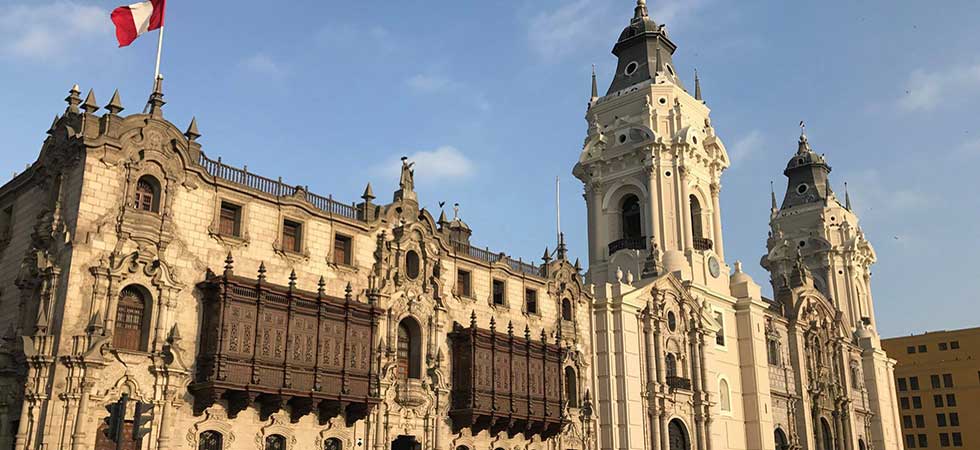 Lima main cathedral
Lima main cathedral
A Feast for the Senses:
Lima is not just a treat for history buffs and foodies; it's a sensory feast for all who venture here. The city's sultry climate, with its sun-drenched days and sultry nights, creates an inviting backdrop for exploration. The intoxicating aroma of freshly grilled anticuchos (marinated skewered meat) wafts from street corners, inviting you to savor Peru's street food culture.
While Lima's urban charms are undeniable, the dramatic cliffs that overlook the Pacific Ocean offer breathtaking views, especially from the enchanting district of Miraflores. Here, you can stroll along the picturesque Malecón boardwalk, watch paragliders take flight over the cliffs, and catch the fiery sunsets that grace Lima's skyline.
How to get to Lima
Getting to Lima, Peru is relatively straightforward, as it's the country's major international gateway. Here's a guide on how to get to Lima from different locations:
By Air:
From North America: If you're flying from North America, many major cities, including Miami, New York, Los Angeles, and Toronto, offer direct flights to Lima. The flight duration can vary depending on your departure city but generally ranges from 7 to 10 hours.
From Europe: European travelers can find direct flights to Lima from cities like Madrid, Amsterdam, and Paris. The flight duration is typically around 12 to 14 hours.
From South America: If you're traveling from within South America, several airlines operate flights to Lima from cities like Buenos Aires, Santiago, Bogotá, and São Paulo, among others. Flight times vary depending on the distance but are generally shorter.
By Land:
While it's possible to reach Lima by land, it's important to note that Peru's rugged geography and vast distances make this option more time-consuming. Most travelers prefer flying. However, if you're already in South America and want to take a more adventurous route, you can consider the following:
From Ecuador: You can cross the border into Peru by bus. The most common route is from Quito to Piura, Tumbes, or Máncora in northern Peru. From there, you can take buses to Lima. This journey can take around 24 hours or more, so be prepared for long travel times.
From Chile: There are long-distance bus services that connect cities in Chile, such as Santiago and Arica, with Lima. The journey can take up to 30 hours or more, so it's advisable to break it up with stops along the way.
From Bolivia: If you're in Bolivia, you can travel by bus to the Peruvian cities of Puno or Arequipa and then take another bus to Lima. The journey can take around 24 to 30 hours or longer.
By Sea:
Lima has a coastal location, but it's not a common destination for cruise ships. However, some cruise itineraries along the west coast of South America may include a stop in Lima's Callao port. If you're on a cruise, check your itinerary for details.
Once you arrive in Lima, you can easily access the city center and other districts by taxi, airport shuttle, or public transportation. Lima's transportation options within the city include buses, taxis, and the Metropolitano bus system, which provides a convenient way to navigate the city.
Weather in Peru
Peru has many climates, from warm and arid desert climate to temperate, frigid, and polar mountain climate to hot and humid tropical rainforests and anything in between. There are three central climatic regions in Peru: the coastal region named Costa in Peru, where Lima is located, with an arid climate. The Andean highlands called Sierra (Cusco, Arequipa, Puno, Huaráz) with a mountain climate; and the Amazon rainforest or selva with a tropical climate.
Due to its diverse geographical and topographical conditions, Peru features 28 out of 32 world climates and a large variety of micro-climates. From desert climate to mountain climate to tropical climate and anything in between can be experienced in the country.
Weather in Lima
Lima's climate is usually described as "mild" throughout the year without noteworthy rain, making the Peruvian capital one of the driest capitals in the world. Generally speaking, Lima features sunny, moist, and warm summers from December to April (with January to mid-March being the hottest period), followed by cloudy, damp, and cool winters from May to November.
By the end of November, the mist and persistent clouds over the Peruvian capital lighten, humidity lowers, and temperatures increase. Around Christmas time, summer arrives in the capital of Peru. Besides some quickly passing early morning fogs, it's mostly sunny, warm, never too hot, but still humid.
From April onwards, temperatures slowly decrease, humidity rises, and cool air moves in from the ocean and condenses in the atmosphere. Lima is again covered in clouds, mist, and fog by May. There is morning or evening drizzle on many winter days, locally called garúa. Winter runs from May to November with June to September being the coolest, wettest and cloudiest months.
Real rainfall is sporadic in Lima, making the Peruvian metropolis the second driest capital in the world. However, while it never really rains in Lima, you still have precipitation in the form of mist or drizzles, especially in the winter months.
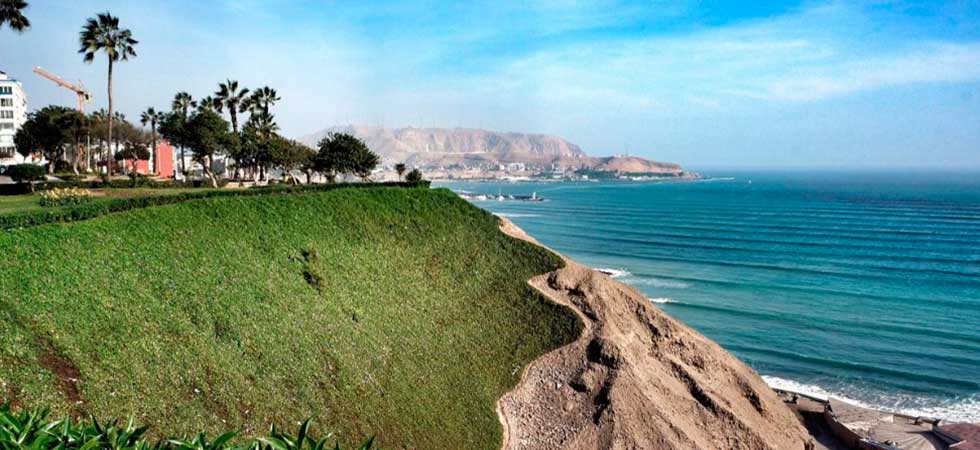 Coastline
Coastline
Safety in Lima: A Traveler's Guide
Peru is a diverse country full of vitality and South American lifestyle. It’s a great country to visit. Peruvian people are very friendly. You should, however, know that you are visiting a country which certainly safety issues.
Lima, like any major city, has its own set of safety considerations that travelers should be aware of. While it's generally a safe destination, it's essential to exercise caution and be informed to ensure a secure and enjoyable visit.
Most crimes against foreign visitors and expats in Peru include petty crimes such as pick-pocketing, cheating, fraud, and theft, sporadically as well robbery. Lima, like many tourist destinations, has its share of scams. Be wary of overfriendly strangers offering assistance or trying to sell you something. Common scams include counterfeit money and distraction thefts, where one person distracts you while another takes your belongings.
You should and can - at least in large part - protect yourself against these offenses with knowledge, proper preparation, and a few simple steps. Violent crimes against tourists are extremely rare. In case of an emergency, the general emergency number in Peru is 911.
Here are some tips for staying safe in Lima:
- Be Cautious in Crowded Areas: Lima's bustling markets, public transportation, and tourist attractions can be crowded, which can create opportunities for petty theft. Keep a close eye on your belongings, especially in crowded places like markets and buses. Consider using a money belt or concealed pouch for your valuables. When withdrawing cash from ATMs, use machines located in well-lit, busy areas or inside banks. Avoid withdrawing large sums of money in one go. Be discreet when handling cash in public.
- Use Reputable Transportation: Stick to registered taxis and rideshare services like Uber for transportation. Avoid hailing taxis off the street, especially at night. Registered taxis have a logo on the door, and Uber provides both a record of your driver and vehicle details.
- Stay in Safe Neighborhoods: Lima has a variety of neighborhoods, some safer than others. Miraflores and Barranco are known for being tourist-friendly and relatively safe. It's advisable to research your chosen neighborhood and choose accommodations accordingly. As in any city, it's advisable to exercise caution when walking alone at night. Stick to well-lit, populated areas and use registered taxis or rideshares to get around after dark . Some of Lima’s districts with a poor reputation : San Juan de Lurigancho, La Victoria, San Martin de Porres, Villa El Salvador, Comas, El Agustino.
- Be Prepared for Traffic in Lima: Lima's traffic can be chaotic, and drivers can be aggressive. Exercise caution when crossing the street, and be aware that pedestrian rules may not always be followed.
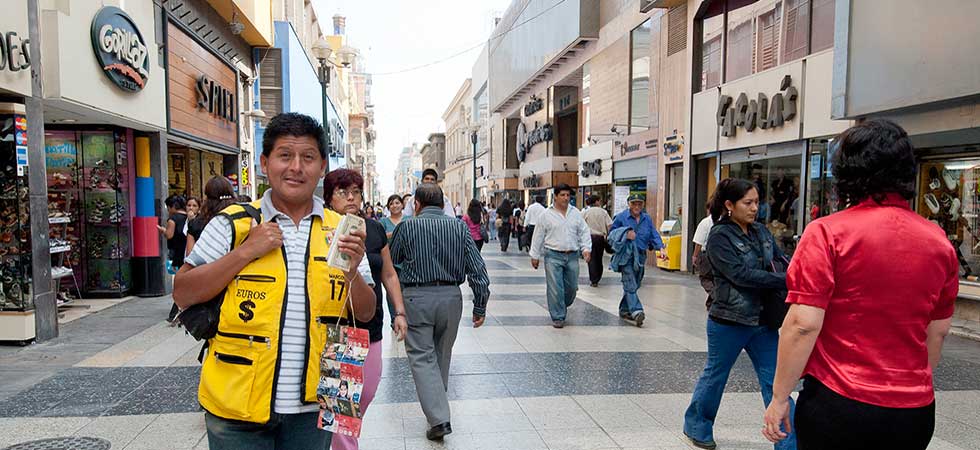 Money exhange in Lima - Peru
Money exhange in Lima - Peru
Internet in Lima: the Digital Landscape in the Peruvian capital
Lima, as the capital and largest city of Peru, offers a relatively robust internet infrastructure. Generally speaking, Lima provides a good level of internet connectivity, especially in the more developed areas and among the major providers. While you can expect decent Wi-Fi access in many hotels, cafes, and restaurants, it's a good idea to inquire about the quality of the internet connection at your specific accommodation, especially if a reliable connection is crucial for your visit. Additionally, for those on the move, local SIM cards and co-working spaces offer convenient options to stay connected while exploring the city.
Internet Speed and Quality
In the more developed and tourist-centric areas of Lima, such as Miraflores, San Isidro, and parts of Barranco, you'll find good-quality internet connections. Hotels, cafes, and restaurants in these areas typically offer free Wi-Fi to patrons, and the speeds are generally sufficient for browsing, streaming, and staying connected with friends and family.
However, in some older or less developed neighborhoods, the internet infrastructure may not be as good. It's a good idea to check with your accommodation provider about the quality of their internet connection if this is essential for your stay.
While the prevalence of internet cafes has diminished with the rise of mobile data and affordable personal devices, you can still find some internet cafes in Lima, especially in the downtown area and near universities. These cafes offer computer rentals and internet access for a fee.
Mobile Data and SIM Cards
If you prefer to stay connected while on the go, purchasing a local SIM card for your unlocked mobile device is an excellent option. Peru has several mobile carriers, including Claro, Movistar, and Bitel. These carriers offer prepaid and postpaid data plans that provide good coverage in Lima and across the country.
- Claro: Claro is one of the largest telecommunications companies in Peru and offers various internet plans for homes and businesses. They have broad network coverage in Lima.
- Movistar: Movistar is another major provider offering internet services in Lima. They provide a range of plans, including fiber optic connections in certain areas.
- Bitel: Bitel is known for offering competitive pricing and has been expanding its coverage in Lima and other urban areas.
Digital Nomads in Lima & Co-Working Spaces:
For digital nomads and remote workers, Lima has a growing number of co-working spaces. These spaces offer high-speed internet, office amenities, and a professional environment. Some popular co-working spaces in Lima include Urban Station and La Maquinita.
Money in Lima
The official currency of Peru is the Sol, denoted as S/. It's divided into 100 centimos, with coins available in denominations of 10, 20, and 50 centimos, as well as 1 Sol, 2 Soles, and 5 Soles. Peru's current banknotes are not only visually striking, featuring famous Peruvian figures on the front and stunning representations of the country's remarkable archaeological sites and unique flora and fauna on the reverse, but they also incorporate advanced security measures, reflecting the nation's unfortunate reputation as a hub for counterfeit currency production.
Regrettably, Peru has grappled with counterfeit money issues for several decades. Consequently, exercise caution when exchanging currency on the street or receiving change in Soles. It's advisable to decline damaged banknotes, even if they've been mended. Attempting to use these notes for payment may pose challenges, as they are often rejected at various establishments. While certain tourist-related businesses, such as travel agencies and hotels, may accept US Dollars, local shops, taxi drivers, supermarkets, and restaurants typically only transact in the local currency. Therefore, converting your Dollars to Soles when dealing with day-to-day transactions is essential to ensure smooth and hassle-free payments.
Always carry some small change, preferably in your pockets. Particular taxi drivers can't or don't want to change, and the same happens in smaller shops, kiosks, or street vendors. If you keep some coins in your pocket, you don't have to open your wallet in a crowded street and can quickly pay small amounts.
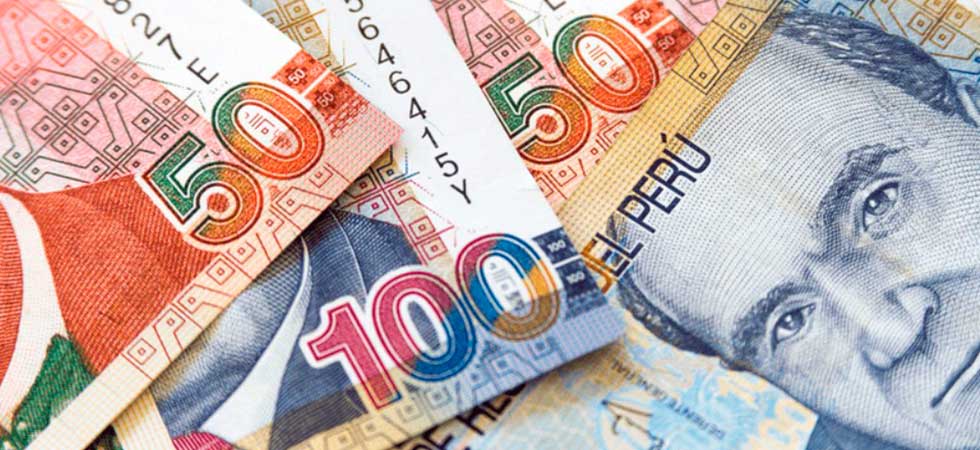 Money in Lima - Peru
Money in Lima - Peru
Tipping in Lima
Giving tips to taxi drivers is not a common practice in Peru, and at budget-friendly lodgings like hotels, hostels, or backpacker accommodations, tips are not expected. However, in mid-range to upscale hotels, you'll typically encounter a service charge of 10% automatically included in your invoice. When it comes to tipping, it's advisable to do so in cash rather than adding the tip to your credit card statement.
You don't have to leave a tip in modest, small local restaurants, cafes, food stalls within markets, or street vendors. However, in fine-dining establishments, you can consider adding approximately 10% as a gratuity unless a service charge has already been incorporated into your total.
Health Tips for Travelers in Lima
Water Safety: Drinking tap water in Lima is not recommended. The water quality can vary, and it's better to err on the side of caution. Stick to bottled water for drinking and brushing your teeth. Also, avoid ice in your drinks at restaurants, as it may be made from tap water.
Stay Hydrated: Lima's climate can be arid, and you may not even realize how much you're sweating. Drink plenty of bottled water to stay hydrated, especially if you're spending time outdoors or exploring the city.
Sun Protection: Lima's proximity to the equator means intense sun (when the sun is out). Even when it is cloudy, use sunscreen.
Mosquito Precautions: Lima doesn't have a significant mosquito problem. If you plan to travel to other regions of Peru (like the Amazon), take precautions. Use mosquito repellent and wear long sleeves and pants during evenings and nights when mosquitoes are more active.
Food Safety: Lima is famous for its delicious cuisine, but be cautious when eating street food. Make sure it's cooked and served hot. Stick to reputable restaurants, especially for seafood, which is a local specialty. Tip: Bring a small bottle of hand sanitizer when soap and water are not readily available, especially before meals.
Vaccinations: Depending on your travel plans within Peru, consult with a travel medicine specialist about recommended vaccinations. Yellow fever, for example, may be required or recommended if you're visiting certain regions.
Healthcare standards in Lima are generally good, and you can find reputable hospitals and clinics in case of emergencies. Having travel insurance with medical coverage is a wise precaution.
Travel out of Lima
If you plan to travel to the Andes (Cusco, Arequipa, Puno, Huaraz, Ayacucho), be aware of altitude sickness. Allow time for acclimatization and stay well-hydrated. If you plan to traveling to the Amazon (Manu, Tambopata, Iquitos), inform yourself about malaria pills an yellow Fever. Consult with a healthcare professional about medications the necessary vaccinations or supplements that can help prevent or alleviate altitude-related symptoms.
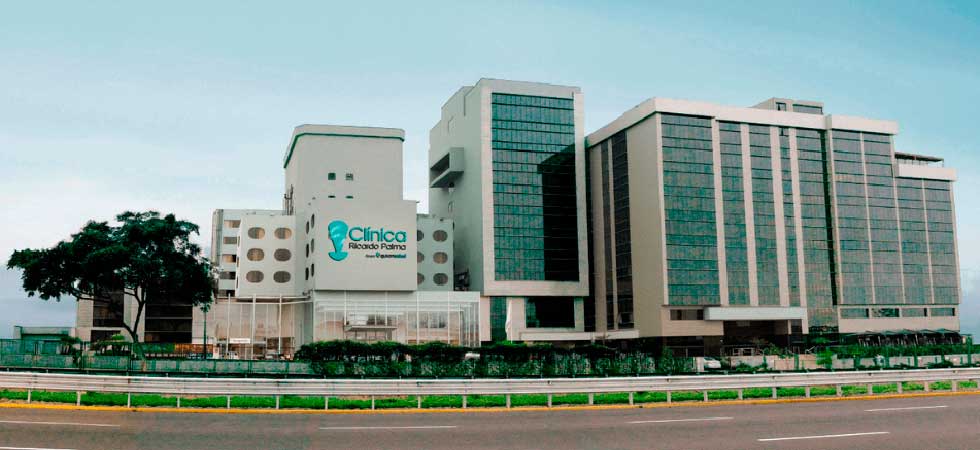 Clinica Ricardo Palma
Clinica Ricardo Palma
Public Holidays in Lima, Peru
Lima, the capital of Peru, celebrates a range of public holidays throughout the year, each offering a unique glimpse into Lima’s rich culture and history. Some businesses and government offices may be closed on these dates
New Year's Day (Año Nuevo) - January 1st:Like many places around the world, Lima welcomes the new year with fireworks, parties, and festivities. It's a time for family gatherings and enjoying traditional Peruvian dishes. |
Día de San Valentín (Valentine's Day) - February 14th:Valentine's Day is celebrated in Lima with affectionate gestures, romantic dinners, and the exchange of flowers and gifts among couples. |
Carnival (Carnaval) - February/March:Carnaval is celebrated with great enthusiasm in Lima. Expect colorful parades, lively music, and water fights in the streets. It's a time of joy and celebration leading up to Lent. |
Holy Week (Semana Santa) - March/April:Holy Week is observed with religious processions and events, marking the passion, death, and resurrection of Jesus Christ. Lima's historic churches and cathedrals are central to these observances. |
Labor Day (Día del Trabajo) - May 1st:On this day, workers in Lima and across Peru celebrate their contributions. You'll find parades, speeches, and labor-related events. |
Independence Day (Día de la Independencia/ Fiestas Patrias) - July 28th and 29th:This is one of the most significant holidays in Peru. Lima hosts grand parades, fireworks, and cultural exhibitions to commemorate its declaration of independence from Spanish rule in 1821. Independence Day celebrations continue into Fiestas Patrias, which includes traditional music, dance, and a focus on Peruvian cuisine, especially dishes like ceviche and anticuchos. |
Feast of Santa Rosa de Lima - August 30th:Lima's patron saint, Santa Rosa de Lima, is honored on this day with religious processions, masses, and pilgrimages to her shrine. |
All Saints' Day (Día de Todos los Santos) - November 1st:This is a time to remember and honor deceased loved ones. Families visit cemeteries to clean and decorate graves, leaving offerings and flowers. |
Christmas (Navidad) - December 25th:Christmas in Lima is a magical time with festive decorations, nativity scenes, and lively celebrations. Families come together for a traditional Christmas Eve dinner (Nochebuena), often featuring roast turkey and panettone. |
New Year's Eve (Nochevieja) - December 31st:Lima bids farewell to the year with vibrant street parties, fireworks, and the tradition of eating 12 grapes at the stroke of midnight for good luck in the coming year. |